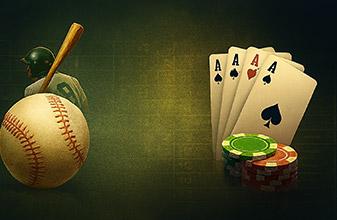Baseball Totals

King Yao is the author of Weighing the Odds in Hold‘em Poker, and Weighing the Odds in Sports Betting. He uses his experience from making millions in financial derivative markets and translates it into gambling. Since he left his trading position in 2000, he has been playing poker and betting on sports. He travels to Las Vegas frequently, especially during football season.
Totals are bet on Major League Baseball games. You can bet whether the combined scores of both teams will be over or under a number, henceforth referred to as the betting total so as not to confuse it with the actual total of the game. If the actual total is the same as the betting total, then the bet is a push. Sometimes different sportsbooks will have different betting totals on the same game.
The vigs on the over and under are typically adjusted to price the difference so there is no clear arbitrage or obvious middle opportunity. Here is an example of two different totals at two sportsbooks.
Sportsbook A Sportsbook B
Over 7 -130 Over 7.5 -105
Under 7 +110 Under 7.5 -115
At Sportsbook A you can bet over 7, but must lay 130 to win 100. At Sportsbook B you cannot bet over 7; that option is not available. If you want to bet the over, the betting total at Sportsbook B is 7.5. The vig on the over is friendlier to compensate for the half-run difference; you risk 105 to win 100.
Once you have decided on a particular wager, how do you figure out which line is best? If you are looking to bet the over, then betting over 7 seems better because you will push if the actual total is 7. Betting over 7.5 means you will lose if the actual total is 7. But you risk less to win the same amount. Given the difference in the vig, which one is the better bet?
MLB Total Push Rates
Using a database of games and totals, I was able to calculate the push percentages for games that had betting totals within a half-run of the actual total. For example, I looked at the percentage of games that landed exactly on 7 when the betting total was 6.5, 7 and 7.5.
More Odds than Evens
Baseball totals are more likely to be odd scores than even. This is intuitively logical since a baseball game cannot end in a tie; tie games always have even totals. When the score is tied after 9 innings, the teams keep playing until there is a winner. A game cannot end in a 4-4 tie, but can end with one team winning 5-4. This means games are more likely to end with odd totals (7 and 9) than even totals (8 and 10). For example, the actual total is 7 during 12.4% of its relevant games (betting totals of 6.5, 7 and 7.5), while the actual total is 8 during 7.2% of its relevant games (betting totals of 7.5, 8 and 8.5).
This is part of an occasional series of articles.
Excerpted with permission from the e-book version of Weighing the Odds in Sports Betting by King Yao, edited for this format.











Please log in or register to leave a comment